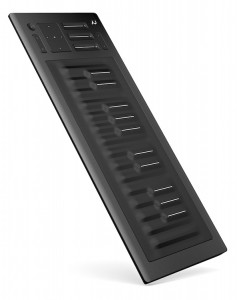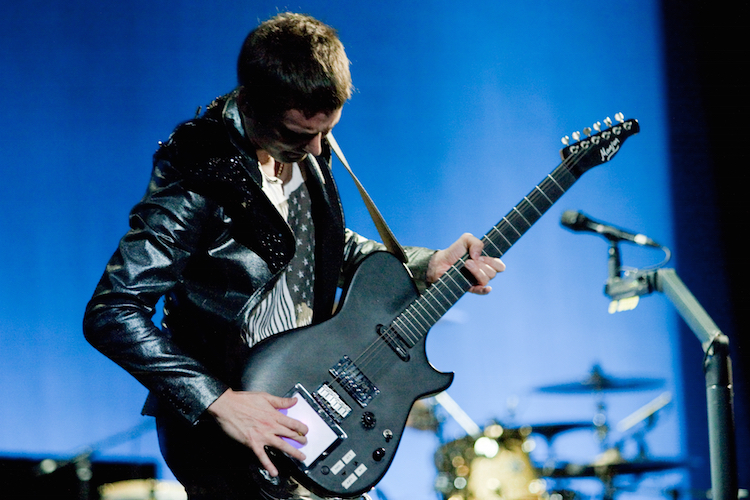Creative Controllers: Next Generation Interfaces for Audio & Music Creation
While there’s still a lot to love about vintage-style synthesizers like the Minimoog Voyager, Roland Jupiter or Korg MS-20, there is now an undeniable trend toward creative next-generation controllers underway, and it is helping to shape the future of music.
From pad-based interfaces like the Ableton Push 2, to the plushy “keywave” surface of the ROLI Seaboard Rise, join us as we take a look at some of the coolest new controllers and instruments that are changing the way that music is made:
ROLI Seaboard & Rise Controllers

The ROLI Seaboard and Rise are one of many new controllers that are helping to change the shape of music.
If you follow music technology closely, chances are that you have already heard of the ROLI Seaboard by now. And if you haven’t been acquainted with this stunning new instrument just yet, you are in for a treat.
ROLI has developed a revolutionary line of MIDI controllers that feature a squishy black silicone surface filled with anywhere from 25 to 88 “Keywaves”. The benefit of this unique playing surface is that this controller features 5 dimensions of touch and expression: Strike, Glide, Slide, Press, and Lift.
“Strike” is the velocity with which you initially hit the note. “Glide” is the horizontal movement from one side of a keywave to another that affects pitch, allowing for full and continuous glissando from note to note. “Slide” is the vertical movement up and down a keywave, that you can map to filter cutoff, volume, or in theory, to any parameter. “Press” is the pressure applied to a keywave after the initial strike, and finally, “Lift” is the speed of release from a keywave, either of which can be mapped to the parameter of your choice.
These new dimensions of expression allow you to apply glissando to full chords, add vibrato, or modify sounds in almost any way imaginable all without having to reach for a knob or foot controller.
Additionally, the more cost-effective Rise controller comes with ROLI’s Equator software which, in itself, is a powerful instrument and sound design tool. Starting at $799, the smallest ROLI Rise controller is reasonably priced, but if the 25 or 49 keywave surface seems too limiting, Roli also makes a Seaboard Grand model in three sizes: 37 key [$1,999], 61 key [$2,999], and 88 key [$8,888].
The Grand series features a higher-quality keywave surface and built-in sounds, meaning it can be used as a MIDI controller or standalone synth. Although much heavier and more expensive than the Rise models, they are truly unique expressive instruments.
Recently, Roli released their new iOS app, NOISE, which is very similar to the Roli Rise and Equator synth, making use if the new iPhone 6S’s pressure-sensitive screen and allowing you to make expressive music on the go. You can even hook up a Roli Rise to the App over bluetooth, and effectively using your phone as a portable sound module.
Ableton Push 2
Ableton released their new Push 2 controller late last year. It features pads as the primary playing surface, and unlike the ROLI line, it features many knobs, buttons, and even slider. This makes sense though as the Push is designed to only work with Ableton Live. (Though you can rewire the Push to work with Logic, it’s not really recommended).
Push 2 makes using Ableton a really interactive experience. You can use the controller for finger drumming, sequencing beats, playing samples from your computer, playing melodies and/or chords with the pads, manipulating plugin parameters, and adjusting the volumes and panning of individual tracks.
If you are interested in electronic music, looping, or remixing, the Push 2 should be high on your list of musical goodies to check out. Starting at $799, the Push 2 is tied in price with the Roli Rise and both do incredibly unique things.
Roger Linn Linnstrument
Roger Linn, is the creator of the Linn LM-1, the first programmable drum machine to use digital samples of acoustic drums. The second variation of it was the LM-2, also called the Linn Drum, and it was used by artists including Prince, Michael Jackson, and Kraftwerk, and it helped to shape the sound of the 1980’s.
Now, Roger Linn is showing off his new “Linnstrument” to the world, and it has been getting press from major media outlets including Forbes, Harpers, Wired, as well as the usual myriad of music magazines.
At first glance, this MIDI controller appears to be a simple pad controller, much like Push 2. However, once you hit a pad, you’ll quickly notice that you can slide your finger for vibrato, bending the note like you can on a guitar.
The melodic layout for the instrument is more similar to the Push 2 than the Rise, and unlike the 5 dimensions of touch found in the Rise, the Linnstrument only offers control over timbre, pitch, and velocity & loudness.
One of the key benefits of the Linnstrument is that it is relatively easy to play it standing up, and, if you are not already familiar with piano and have no prior piano technique, the Linnstrument may be faster to learn to play than the Rise. Unlike the Push 2 or Roli Rise, it sports a simple onboard MIDI In and MIDI out connection. At $1500, this device is almost twice the starting price of the Roli Rise 25 or Push 2, but combines some of the best of both worlds.
Numark Orbit and XY MIDIpad
Unlike the Push 2, Numark’s Orbit isn’t a controller you can really write melodies on effectively, but it allows you to trigger notes, effects, or really any parameter within Ableton.
This relatively cheap ($40 approx) controller can be used wirelessly. Check out the video below of Ableton instructor Dan Freeman using one attached directly to his Sadowsky bass so he can have more control over his Ableton Live sets. Jump to 8:25 below to see it in action:
This simple setup allows Freeman to have creative control over Ableton in real-time, processing his bass or vocal sounds as well as launching pre-loaded clips. MUSE’s Matt Bellamy takes a similar approach with several of his custom Manson guitars, adding an XY MIDIpad that is similar to the Korg Kaoss Pad. An added benefit of these two controllers is the added built in light show for live performances.

Matt Bellamy of Muse manipulates an XY MIDIpad installed on his guitar. Image courtesy of Flickr user moses_namkung.
iPad/iPhone
There are so many MIDI controller apps for iOS devices today (and even fully fledged recording programs) that you could even consider completing professional music productions right on your phone. Here are just a few of many that are particularly groundbreaking:
MorphWiz: This app, developed by Jordan Rudess of Dream Theater. allows you to play your iPad as a synth. The built in sounds are great, and Rudess even uses this app live and in the studio with Dream Theater. You can also set the scale that each synth loads up when you start up a preset and you can either choose to set it so that
touchAble: This app allows you to essentially transform your iPad into a Ableton Push. It can be hooked up wirelessly or via a USB to your computer, and it can actually be nicer than a Push 2 in some cases as certain iPad models have a touchscreen that’s even bigger than the Push.
TouchOSC: This iOS app allows you to control practically any audio program in your computer from Mainstage 3 and Logic Pro X to Ableton Live. Simply download the app on your iOS device of choice and then download Live Control on to your computer from the App Store. You can then open up the TouchOSC Editor app on your computer and start controlling your DAWs using your iOS touchscreen device.
Garageband for iOS: Apple recently updated their Garageband iOS app, adding a “loops” section that is very reminiscent of Ableton’s Clip viewer. This new version acts as a fully functional DAW with multitrack recording capabilities. If you come up with a song idea while playing one of the many virtual instruments within it, you can record it right there on your IOS iPhone or iPad. From here, you can export your Garageband file to your computer and fully expand the idea on a desktop version of Garageband, Logic, or convert it to work with practically any other DAW.
Throughout history, new technology has driven the shape that music will take. In at least this fundamental way, music in the 21st century is sure to share a lot in common with the past. Even if you do find yourself jamming out on a holographic synthesizer while flipping an ollie on your hoverboard some day.
Please note: When you buy products through links on this page, we may earn an affiliate commission.






